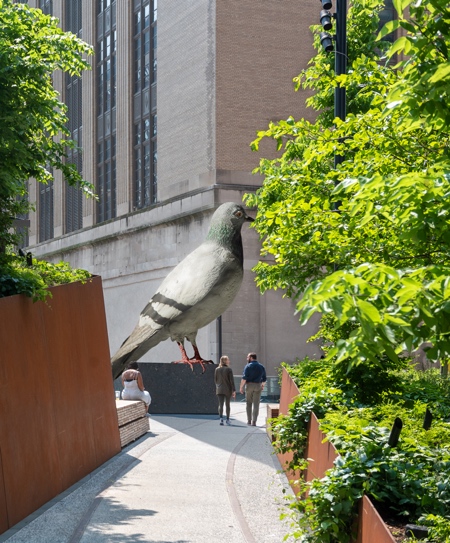
“Massive Pigeon Sculpture Installed on New York’s High Line”

**Giant Pigeon Sculpture Commands Attention on New York’s High Line**
If you stroll along the High Line in New York City in the coming months, you’ll be greeted by an imposing sight: a 16-foot-tall, 2,000-pound, cast-aluminum pigeon. This striking new addition, titled *”Dinosaur”* by Paris-based Colombian artist Iván Argote, is part of the High Line’s acclaimed *Plinth* series.
While the sculpture may evoke a range of reactions — from amusement to bewilderment — it is designed to prompt more than just a chuckle. Argote’s goal is to stir reflection on migration, identity, and who deserves to occupy public spaces historically reserved for monumental figures. Through his larger-than-life pigeon, Argote draws a connection between New York City’s ubiquitous feathered residents and the city’s migrant history.
### A Symbol of Migration
“Even the pigeon, a New York fixture, migrated here and made the city their home,” reads a metal sign accompanying the sculpture. Pigeons, often dismissed as a nuisance or relegated to the background of the city’s frenetic pulse, become central to Argote’s artistic commentary. For him, these birds represent not just an urban staple but a deeper metaphor for New York’s diverse and ever-changing populace.
“This is a city of migrants; in a way, it was built by migrants,” Argote explains in an interview with *Hyperallergic*. The pigeon, familiar to all New Yorkers, serves as a vehicle to explore themes of belonging, diversity, and the role migration plays in shaping the city’s identity. The sculpture’s colossal size brings renewed attention to a creature most people ignore, encouraging a reevaluation of its significance.
### Challenging Conventional Monuments
The location of *Dinosaur*—on a plinth, traditionally reserved for statues of military leaders, colonizers, or celebrated historical figures—raises questions about who and what is memorialized in public spaces. By featuring an animal often associated with filth or urban annoyance, Argote disrupts expectations and invites discourse around what or whom we choose to glorify.
Cecilia Alemani, the Director and Chief Curator of High Line Art, underscores this point: “What happens when you put an animal in a place that has been for centuries devoted to men on horseback, leaders, or colonizers?” The pigeon on a plinth essentially reframes the dialogue about monuments and their subject. It subverts tradition, placing emphasis on life’s more mundane but integral elements, which are often overlooked.
### Reactions and Interpretations
Neither Argote nor Alemani appear interested in dictating how the public should react to the sculpture. In fact, they seem to welcome varied interpretations, even expecting some friction along the way. Alemani believes the most successful public artworks are those that, “function as a sort of catalyst for imagining new futures and pushing your imagination. But also, something that creates friction with the cityscape.”
New Yorkers are no strangers to pigeons; they evoke everything from affection to disdain. “I know of the importance of the pigeons here in New York, and all the kind of reactions they generate: love and passion or hate and disgust,” Argote says. It is this complex relationship that the artist seeks to highlight, using the pigeon as a symbol to provoke multifaceted conversations about belonging, the urban experience, and public art.
### Creating the Giant Pigeon
While the concept may seem simple at first glance, the creation of *Dinosaur* was anything but. The project took years to come to fruition, first proposed by Argote in 2020 and brought to life over eight months in 2024. The pigeon’s massive cast-aluminum body was assembled in Mexico and painted in New Jersey, with final touches completed in New York City. Installing the sculpture on Tenth Avenue required a crane and a lane closure, further elevating the pigeon — both literally and metaphorically — to a central figure in the urban landscape.
### Meeting Pigeon Influencers
Perhaps unsurprisingly, the city’s pigeon community—including a niche group of “pigeon influencers”—has also taken an interest in the artwork. During a preview event, a domesticated pigeon named Frankie, owned by filmmaker Jacqueline Quigley, made an appearance, outfitted with a specialized leash and harness. Frankie’s owner praised the sculpture, reflecting on its connection to the city’s mentality: “They are the pigeons. They’re scrappy, they’re feisty. They don’t give a fuck.”
This statement perhaps best encapsulates the resilient spirit both of New Yorkers and the pigeon that now towers above them. In a city where millions try to make a home and leave their mark, the humble pigeon — often scorned but impossible to ignore — becomes an unlikely but fitting hero.
### Final Thoughts
Argote’s *Dinosaur* will perch on the High Line for the next 18 months